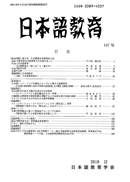Volume 179
Displaying 1-10 of 10 articles from this issue
- |<
- <
- 1
- >
- >|
Featured Article
-
2021 Volume 179 Pages 1-15
Published: August 25, 2021
Released on J-STAGE: August 26, 2023
Download PDF (2406K)
Research Papers
-
2021 Volume 179 Pages 16-30
Published: August 25, 2021
Released on J-STAGE: August 26, 2023
Download PDF (1277K) -
2021 Volume 179 Pages 31-46
Published: August 25, 2021
Released on J-STAGE: August 26, 2023
Download PDF (524K) -
2021 Volume 179 Pages 47-61
Published: August 25, 2021
Released on J-STAGE: August 26, 2023
Download PDF (534K) -
2021 Volume 179 Pages 62-76
Published: August 25, 2021
Released on J-STAGE: August 26, 2023
Download PDF (525K) -
2021 Volume 179 Pages 77-92
Published: August 25, 2021
Released on J-STAGE: August 26, 2023
Download PDF (617K)
Survey Articles
-
2021 Volume 179 Pages 93-108
Published: August 25, 2021
Released on J-STAGE: August 26, 2023
Download PDF (514K) -
2021 Volume 179 Pages 109-123
Published: August 25, 2021
Released on J-STAGE: August 26, 2023
Download PDF (602K) -
2021 Volume 179 Pages 124-138
Published: August 25, 2021
Released on J-STAGE: August 26, 2023
Download PDF (1026K) -
2021 Volume 179 Pages 139-153
Published: August 25, 2021
Released on J-STAGE: August 26, 2023
Download PDF (518K)
- |<
- <
- 1
- >
- >|
